Constructing a gazebo can turn your backyard into an attractive and practical outdoor area. This guide covers everything from permits and design to materials and construction. With Domi's tips and products, you'll create a perfect retreat.
What Local Codes and Permits Are Required?

Before beginning construction, it's crucial to review local laws and secure the required permits. Compliance with building codes ensures that your gazebo is built safely and legally, avoiding fines or dismantling issues. Research local codes by visiting your local government’s website or office.
Apply for a permit by providing detailed plans and specifications for your gazebo. Provide detailed documentation as part of your application. Once approved, an inspection might be required during and after construction to ensure compliance.
How Do You Design Your Gazebo?
Tailoring your gazebo's blueprint demands a thoughtful fusion of spatial constraints and aesthetic vision, ensuring the final structure embodies your outdoor aspirations. With Domi Gazebo's diverse range of options, you can find inspiration and solutions for creating a perfect gazebo that complements your home and enhances your outdoor living space.

Considerations for Choosing the Size and Style of Your Gazebo:
Start by determining the size of your gazebo based on its intended use and the available space in your yard. Domi Gazebo offers various dimensions, ensuring you find the perfect size for your needs.
Size: If you plan to use the gazebo for intimate gatherings or as a quiet retreat, smaller sizes like 8'x8' or 10'x10' may be ideal. For hosting larger parties or creating an expansive outdoor living area, consider larger sizes like 12'x16' or 14'x22'.
Style: Opt for an architectural motif that seamlessly integrates with your dwelling's aesthetic and the encompassing landscape. Domi gazebo offers various styles, including hard-top gazebos, grill gazebos, wood gazebos, sunrooms, pergolas, and wall-mounted gazebos. Each style offers distinct advantages and characteristics, helping you achieve a unified appearance that elevates the beauty of your property.
Match Materials and Colors: Choose materials and colors that blend well with the exterior of your home. Domi gazebos come in materials such as aluminum, galvanized steel, wood, and polycarbonate, providing a range of finishes to match any design scheme.
When you take these factors into account and look through the vast selection at Domi Gazebos, you can create a stunning and practical gazebo tailored to your outdoor area. The variety of options ensures you'll find the perfect fit for your space. Whether you seek a serene retreat or a vibrant entertainment area, Domi has the ideal solution to transform your vision into reality.
What Supplies and Equipment Are Required to Construct a Gazebo?
Building a gazebo requires selecting quality materials and having the right tools. Here's a simplified list of essentials:

Materials:
- High-Quality Lumber: Strong and weather-resistant, such as cedar, which resists decay and insects.
- Galvanized Screws and Nails: Built to resist rust, ensuring your gazebo lasts for years.
- Concrete Mix: For setting the foundation posts, providing stability.
- Durable Roofing Options: Choose from shingles, metal panels, or polycarbonate sheets for weather protection.
Tools and Equipment:
- Circular Saw: This tool is utilized for trimming wood to the necessary sizes.
- Post-Hole Digger: For digging foundation holes.
- Hammer: For driving nails.
- Level: To ensure all elements are aligned properly.
- Safety equipment: gloves, safety glasses, hearing protection and sturdy footwear.
Where Should You Build Your Gazebo?
Deciding on the best location for your gazebo is essential, affecting both its use and look. Here’s a concise guide to picking the ideal spot:
Proximity to the House:
Placing your gazebo close to your house makes it easily accessible, ideal for entertaining guests or enjoying meals outdoors. It also simplifies running utilities like electricity for lighting or a fan.
Aesthetic Appeal:
Choose a spot that offers pleasant views and complements your yard. Consider how it integrates with pathways, plants, and other features. Think about the sun's path to provide enough shade during peak hours.
Evaluating these aspects will direct you to the best spot for your gazebo. This will maximize its functionality and enhance the beauty of your outdoor space.
How Do You Prepare the Site for Your Gazebo?
Getting the site ready for your gazebo is vital for its durability and stability. Establish a solid foundation by adhering to these guidelines.
Clear the Area:
Begin by removing any clutter, stones, and plants from the site to establish a tidy work environment. This initial step helps lay a strong foundation and prevent future issues related to stability and plant growth.
Mark the Perimeter:
Next, mark the perimeter of the gazebo using stakes and string. This ensures you have a clear outline of the structure, guiding you during excavation and construction. Accurate marking is essential for maintaining the correct dimensions and alignment of the gazebo.
Excavate the Site:

Excavating the site involves removing the topsoil to help create a level base. A flat foundation is crucial for stability, as it ensures even weight distribution and prevents long-term structural problems.
Level the Ground:
Utilize a rake along with a carpenter's level to even out the ground. Make adjustments as needed to guarantee a smooth and level surface. A properly leveled ground simplifies the construction process and enhances the gazebo's durability.
Ensure Proper Drainage:
Good drainage stops water buildup, which protects the foundation and prevents wood decay. Make sure the site slopes slightly away from the gazebo to direct water flow away from the structure. Effective drainage is crucial for preserving the gazebo's structure and enhancing its durability.
By following these steps, you can prepare a solid and stable site for your gazebo, ensuring its longevity and functionality.
How Do You Build the Foundation?
A robust base is essential for ensuring your gazebo's durability and stability. Adhere to these guidelines to create a sturdy foundation.
Mark the Post Locations:
Use your marked perimeter to identify where the posts will go. Ensure the spacing is even and accurate according to your gazebo's design.
Excavate the Holes:
Use a post-hole digger to excavate holes to the required depth, typically 2–3 feet. Make sure the holes are uniform in depth to provide consistent support.
Insert the Posts:
Set the posts into the dug holes, making sure they stand upright with the help of a level. Make any needed adjustments to ensure the posts remain straight and properly aligned.
Pour Concrete:

Fill the holes around the posts with concrete until it reaches ground level. Ensure the concrete is evenly distributed and surrounds the posts completely.
Allow Concrete to Cure:
Ensure the concrete is completely set before continuing with the building process. The duration typically ranges from one to two days, influenced by the type of concrete used and the prevailing weather.
By following these steps, you can build a solid and stable foundation for your gazebo, ensuring its longevity and stability.
How Do You Build the Frame of Gazebo?
Constructing the frame of the gazebo involves attaching base beams to the posts using galvanized screws, adding vertical supports, and attaching horizontal cross beams for additional stability.
Regularly use a level to ensure all beams and posts are perfectly vertical and horizontal. Securely fasten all screws and bolts to prevent any shifting and to ensure the frame remains sturdy.
How Do You Install the Roof?
Installing the roof of your gazebo involves selecting durable materials and following straightforward steps to ensure a secure and weatherproof structure. Here's a simplified guide:
Install Roofing Materials:
Prepare the Roof Frame:
Construct the roof frame on the ground for easier assembly. Securely attach the rafters and cross beams using galvanized screws and nails.
Lift and Secure the Frame:
Lift the assembled roof frame onto the gazebo with help. Ensure it is level and stable by securing it to the vertical posts.
Attach the Roofing Material:
- Aluminum: Both are light in weight and resistant to rust. Place aluminum sheets over the rafters, overlapping each sheet to prevent leaks. Secure them with weather-resistant screws.
- Galvanized Steel: Strong and rust-resistant. Position the steel panels on the roof frame and fasten them with appropriate screws to withstand weather conditions.
- Wood: Natural and sturdy. Install wooden shingles or planks starting from the bottom edge, ensuring each layer overlaps to prevent water penetration.
- Polycarbonate: Lightweight and impact-resistant. Lay the polycarbonate sheets on the roof frame and secure them with screws that have rubber washers for a watertight seal.
By combining the materials and installation steps, you can efficiently install a durable and attractive roof on your gazebo. This ensures it provides reliable shelter and enhances your outdoor space for years to come.
How Do You Add Decorative Features?
Enhancing your gazebo with decorative elements such as lattice panels, lighting, and seating can add a personal touch and increase functionality. Lattice panels provide a decorative touch and additional shade, while string lights or lanterns create a cozy ambiance.
Adding comfortable outdoor furniture like built-in benches or movable chairs makes your gazebo a perfect spot for relaxation and entertainment.
Conclusion
Refer to these instructions to create a delightful gazebo that will elevate the appeal of your garden area. With Domi Gazebo's advice and quality materials, enjoy a durable and stylish gazebo for years to come. If constructing a gazebo yourself isn’t feasible due to time constraints, reach out to Domi.We offer high-quality services from design and construction to maintenance.




Leave a comment
This site is protected by hCaptcha and the hCaptcha Privacy Policy and Terms of Service apply.